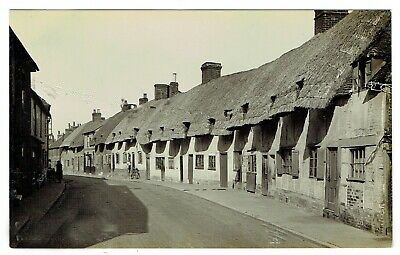
Whitchurch, in Hampshire, an historic photo from the Francis Frith
collection, albeit a century or more after our Mary and George Dance
lived there on a nearby farm.
Mary Swain (1808-1895) & George Dance (1803-1857)
This block will be replaced by LeftMenuGaffey (orByrnes) when the
page is served from a server.
George Dance
- Birth:
- c1803, possibly Baydon, Wiltshire
- Death:
- 4 December, 1858, Knights Enham, Andover , Hampshire
Mary
Swain
- Birth:
- c1808, St. Mary Bourne, Hampshire
- Death:
- 2 May, 1895, Andover, Hampshire
- Marriage:
- 3 December, 1831. Whitchurch, Hampshire
- Children:
- Jonathan (1832-1908)
- Elizabeth (1834 - )
- Mary (c1835 - 1914)
- George (c1836-1893) married Martha Blandford, 3 May, 1864, Andover, Hampshire
- Henry (1837- )
- Sarah (1839 - )
- Thomas (1841 -1911 )
- Lucy (1845 - )
- Solomon (c1844 - 1920)
- Eliza Jane (1848 -1872)
- Charles (1850 - 1931 )
- Alfred (1854 - ?1913)
In 1888, the London evening newspaper , the Star reported:
"Whitchurch is in Hampshire. People who live IN it call it a town. People who live OUT of it call it a village. It is about as big as a good-sized pocket handkerchief. It has three shops and 19 public houses."
And so, 60 years earlier than that
dismissive description, Whitchurch was probably even smaller and more
insignificant (although that references to 19 pubs in a small village is
a bit of puzzle). Nevertheless, it was a place important in our history
of the Dance family. It's where 28 year old George Dance and 23 year old
Mary Swain, met, married, settled down and had all of their 12 children.
(And just by the way, they were to be the grandparents of the Dance
youths who, 50 years later, made the break with farming life in
England and headed to Australia in the 1880s).
George was a shepherd, and records for agricultural labourers and their families for the mid 19th century are sketchy, but it appears that George and Mary may have escaped the sadness of losing children in infancy, although some of the children have been a bit elusive in official records from midway though childhood, so the family's good fortune in that respect may not have lasted.
Most of the family, if not all, started work early, with jobs such as "servant" and "agricultural laborer", "shepherd" and "errand boy" being noted against the names of the children in the 10-yearly census conducted from 1841 onwards. However, the younger children, at least, had some schooling, being described as 'scholars' on one census. By the 1850s, George and Mary, and those of their children who hadn't left home, were living and working at Bradley Farm, on Newbury Road, just outside Whitchurch.
Sometime during the
1850s, the family moved slightly west, to another small village, Knights
Enham, closer to the larger centre of Andover. Knights Enham is
where George fell ill with a fever, and died, in the winter of 1858, at
the relatively young age of 54 years. His death left Mary at home with
three young children, the youngest, Alfred, only four years old.
She was undoubtedly helped by three of her older children still living
with her, while her second youngest, 8 year old Charles, was soon
bringing in a little money as an errand boy.
So, without George,
Mary became a washer-woman, work she continued until well into her
sixties. The 1871 census described her as a "former
laundress". In retirement, she was living, still in Knights Enham,
with five of her adult children, all unmarried and two of them
unemployed - 35 year old Mary and 23 year old Eliza. The youngest in the
family, Alfred, now 17 years old, was a draper's porter; the other two
males, Thomas and Charles were also porters (working for the railway),
and the family home on Enham Road was described as a "railway cottage".

Between then and the next census in 1881, a big upheaval occurred.
For whatever reason, Mary, with only one adult son and one adult
daughter in tow, made the move into Andover itself, taking up residence
at 5 New Street, Andover. It's to be hoped the house was well
insulated for dealing with extremes of weather - that year, a bitterly
cold winter hit southern England, with the heaviest snowfall on record
hitting the Isle of Wight, just off Hampshire's southern coast.
left: New Street, Andover c1900.
left: New Street, Andover c1900.
By
1891, several Dance households had established themselves in Andover..
Mary's
second son George had returned to Hampshire after nearly two decades
farming in Devon. His took up an acreage known as "New
Street Farm", a short distance along New Street from Mary and her
namesake daughter.
Another
son, Solomon, a foreman on the railways, lived with his young family
just one kilometre away in Winchester Street before moving around the
corner to 18 South Street..
Daughter Lucy, who had married a carriage maker Robert Johnston in 1868, also lived in New Street.
Daughter Lucy, who had married a carriage maker Robert Johnston in 1868, also lived in New Street.
Son
George followed his father in one distressing way - he too died at a
relatively young age. In the summer of 1893, aged only 56, George
succumbed to a bout of pneumonia. His mother outlived him by only two
years; in May,1895, Mary died in her New Street home, with her death
being attributed to chronic bronchitis, emphysema, and old age. She was
88.
.